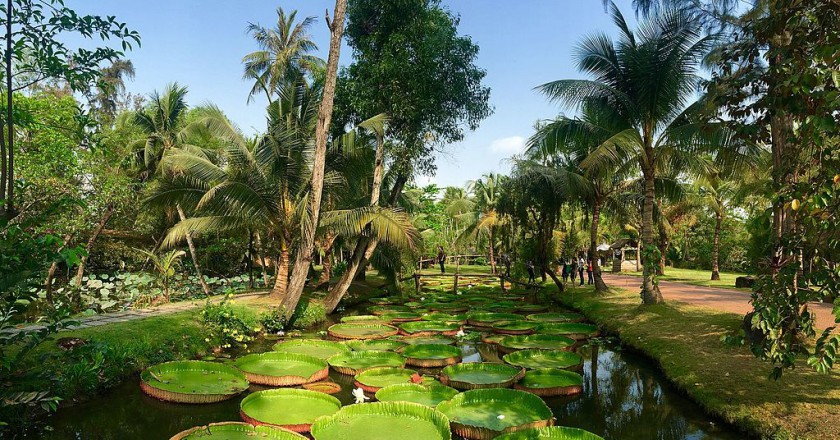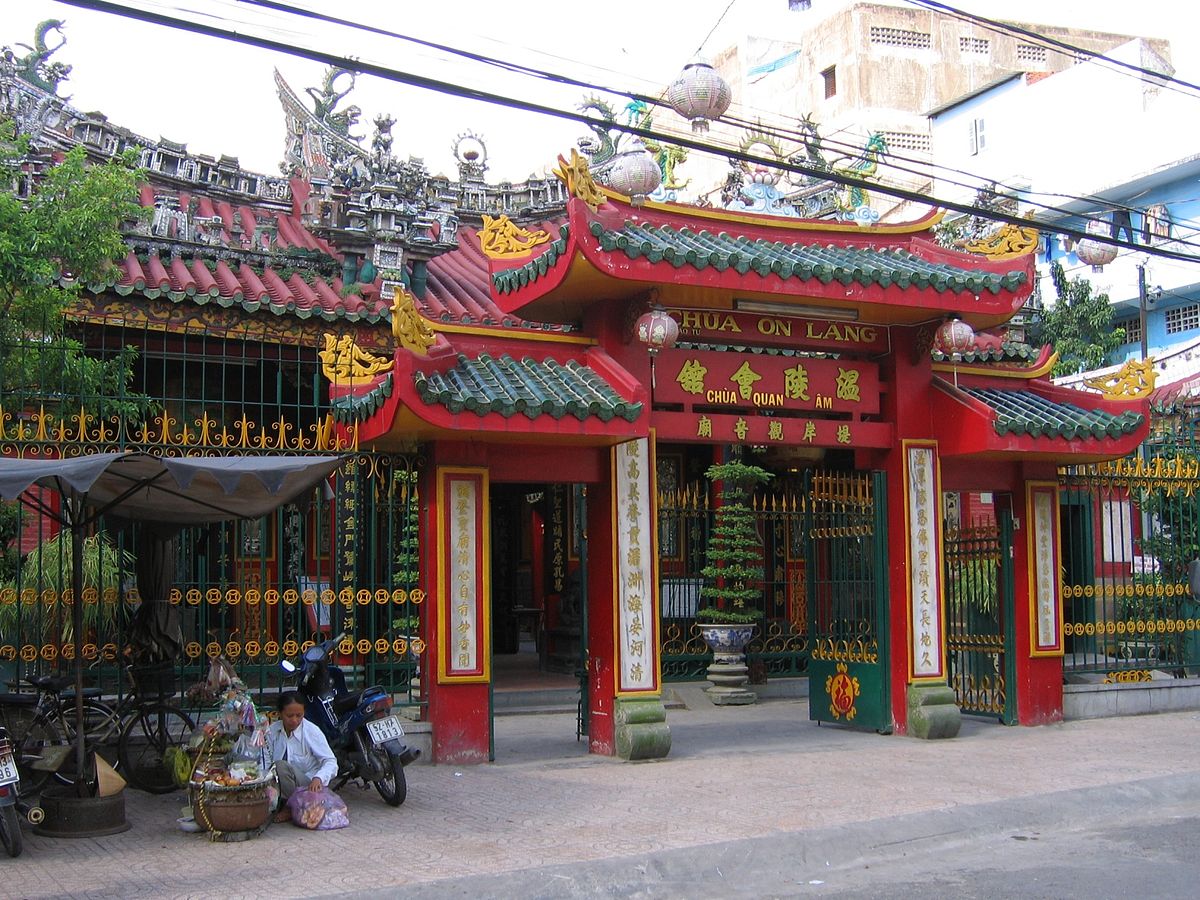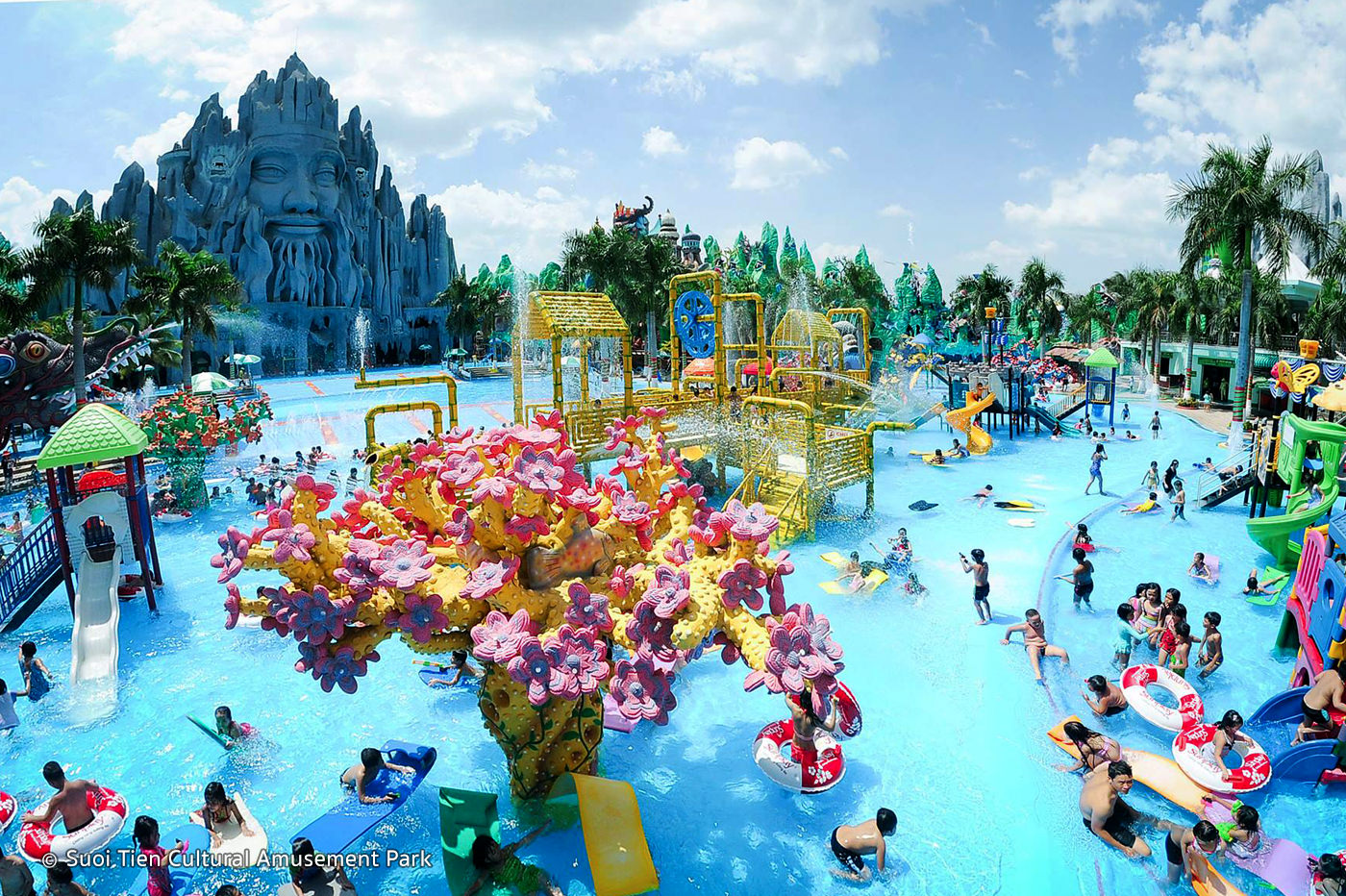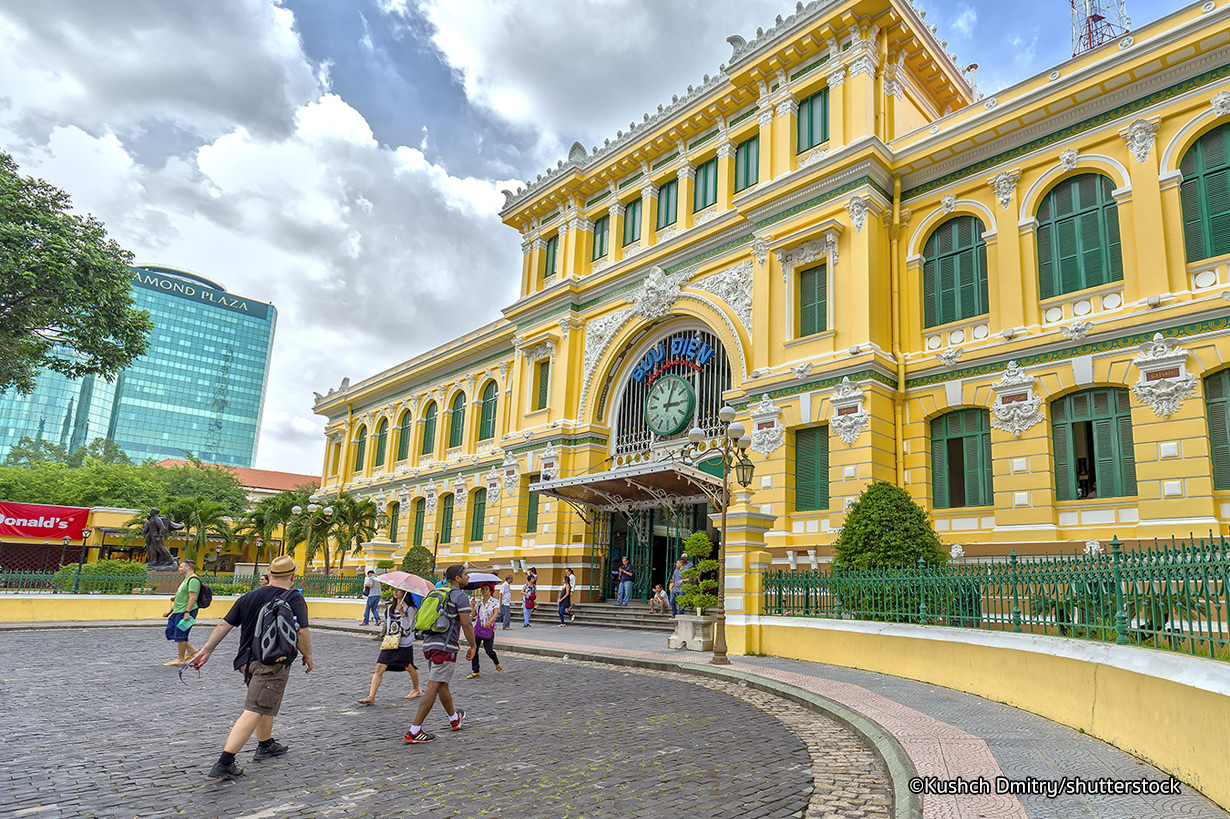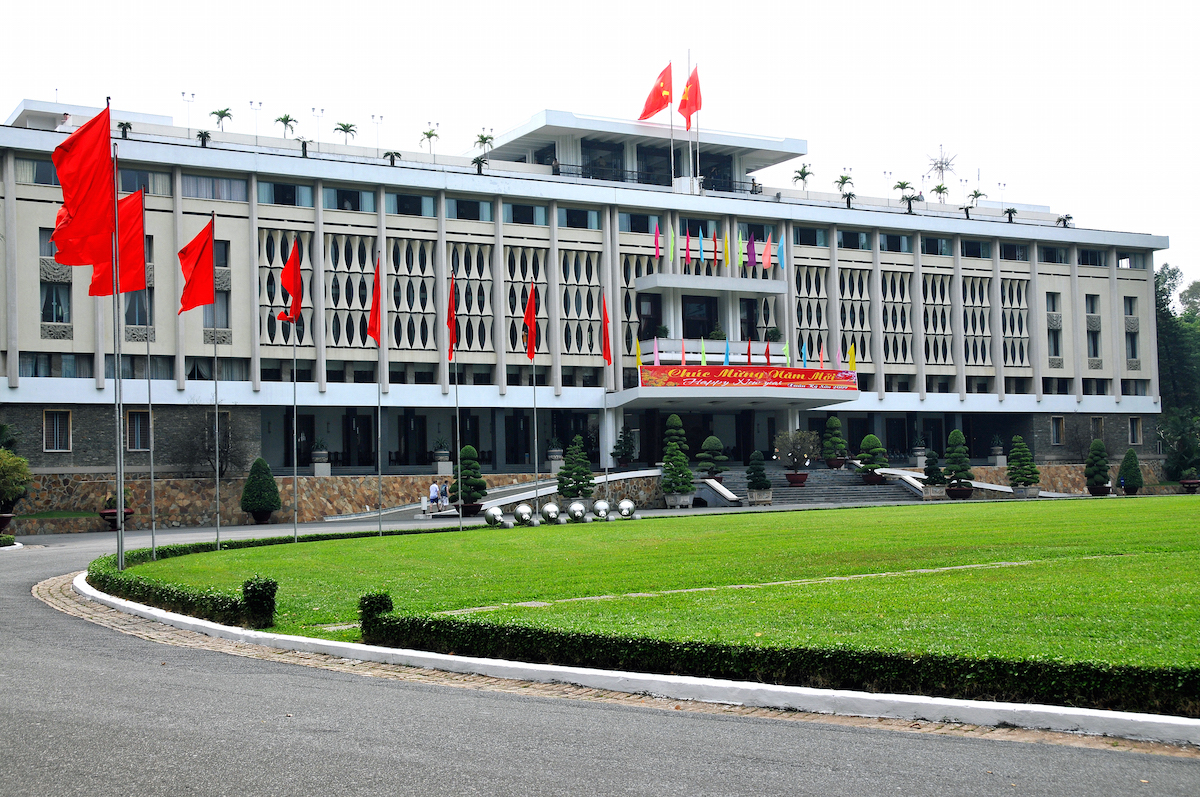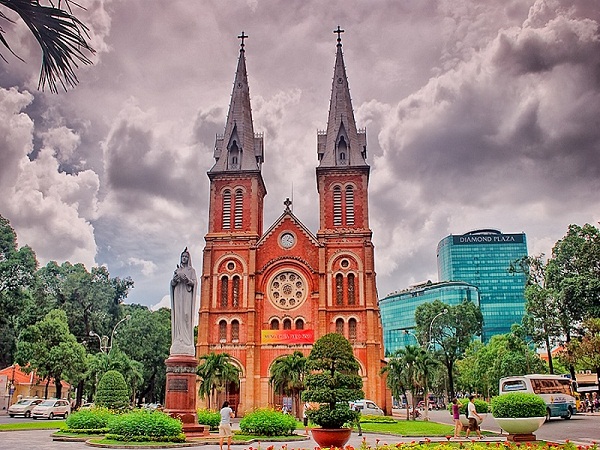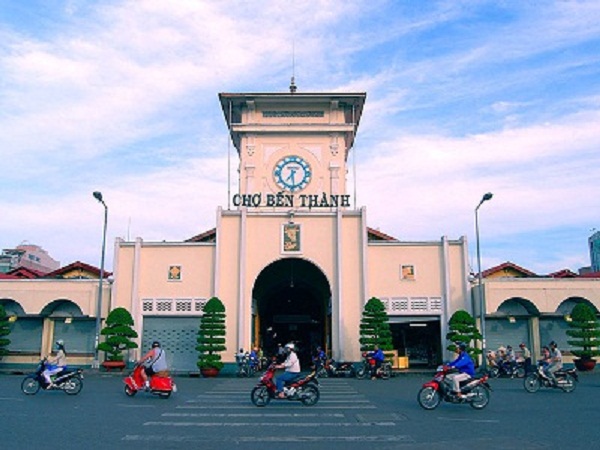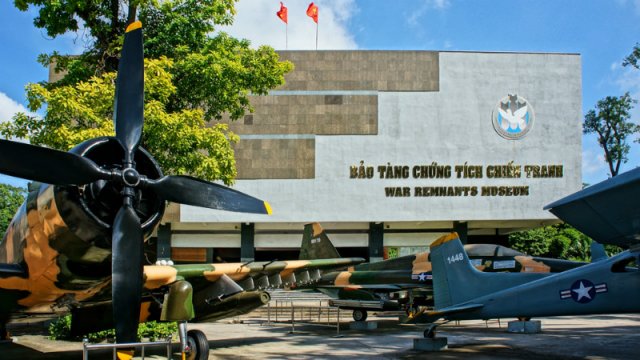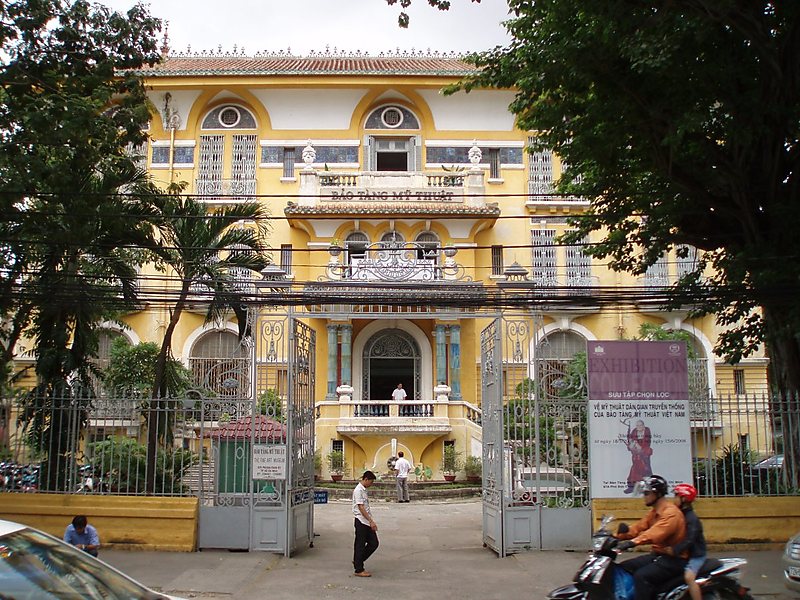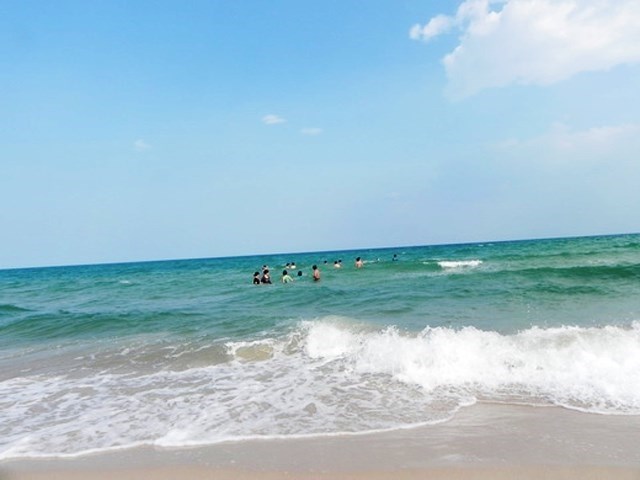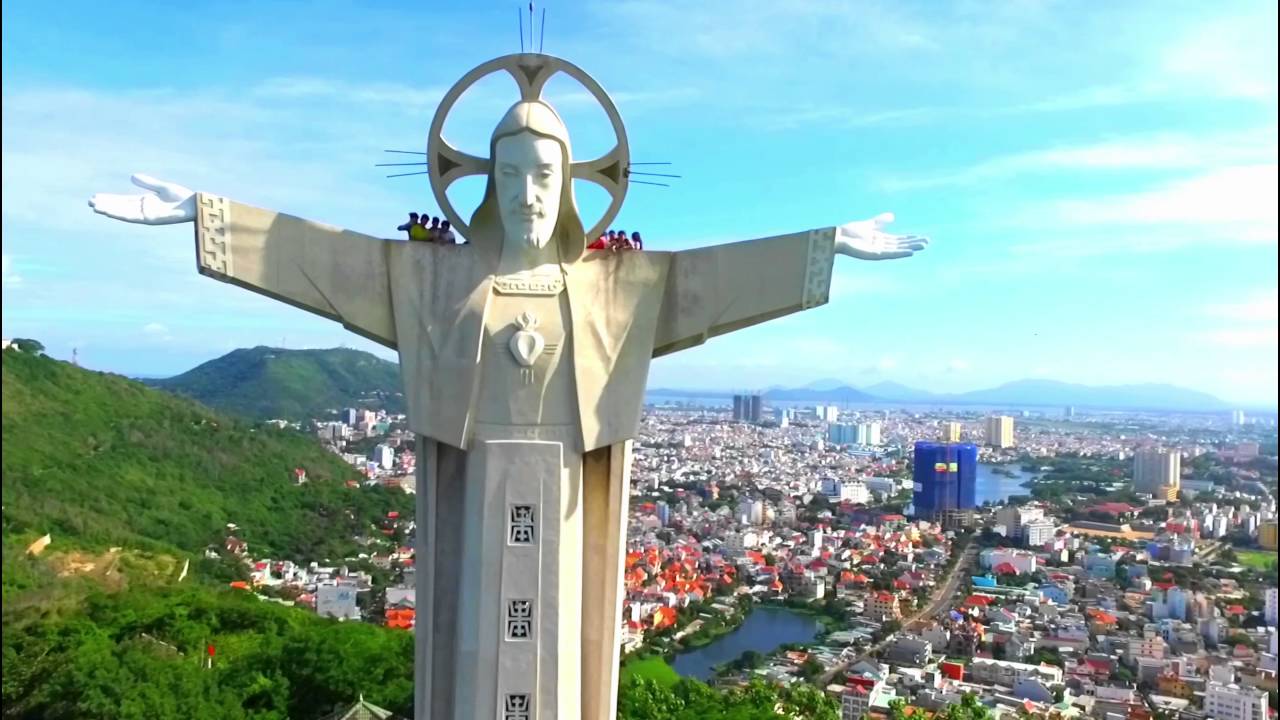Saigon Introduction
Saigon Introduction
Ho Chi Minh City’s architecture and lifestyle is the reconciliation between American and Chinese influence, with many dots of modernity yet without losing Vietnamese traits and as much historical as it is modern.
Reunification Palace is definitely the place to visit, for its significance and archival of Vietnam War. If this building still does not impress you enough, rest assured that museums are abound and the admission fees are generally low. Among the most recommended ones are: Ho Chi Minh Museum, Revolutionary Museum and Vietnam History Museum.
If you are tired of talking about the past and want to learn more about the present, District 1 may be the best way to experience a dynamic and booming economy. Streets and boulevards are lined with tall evergreen trees and you can easily walk around with a map. Here and there you will see men walking and dressed up like those in the Wall Street, amid women wearing conical hat and selling street drinks. A few notable sights you will spot on the way are the city post-office, Notre Dame church and Ben Thanh market.
It might be a relief for some to know that Ho Chi Minh City is also considered the best place in Vietnam for entertainment . The three main amusement parks: Dam Sen, Suoi Tien and Dai Nam are the three complexes with zoos, sceneries, water and non water games - well-fitted for a family trip. There is no Disneyland in Vietnam but these complexes do their job: they replace the fairy tales of Andersen stories with the folk tales in Vietnamese. You play and have fun, while learning about a different culture and tradition.
If Ho Chi Minh has things to win the rivalry against Hanoi, it is the colourful night-life. Bars are open late and vary in style. Adding to that, Ho Chi Minh has many tea-houses which hosts live music performance of both Vietnamese and international artists. For a change, you can also go local for one night or two, hop into one of the street food stalls, order some drink and roasted peanuts and chat until midnight (more ideas to spend your night in Ho Chi Minh City).
With her back turned on a broad plain that stretches west across Cambodia, and with the rich Mekong Delta at her feet, Ho Chi Minh City sits regally on a giant bend in the Sài Gon River.
Bulging with a population of nearly seven million, Ho Chi Minh City, is Vietnam’s largest and most exciting city. While Hanoi is the center of government, Ho Chi Minh City is the nation’s economic heart, and money is on the minds of everyone here (see Our Blog on Hanoi or Ho Chi Minh City). Taxi drivers can recite the latest joint venture regulations, and even shirt makers stay in touch with their foreign customers by e-mail. Time is precious, and people are in a hurry, although conversation often takes a small town tone as bakers and bankers compare their ‘‘inside’’ information at sidewalk cafés.
Long before traffic choked the center of the city, Saigon had already been christened the ‘‘Paris of Asia’’ for its wide boulevards lined with stately trees and magnificent French villas. For a moment you may be fooled by the smells of coffee and baking bread, and by old Renaults sounding their horns at roundabouts.
The best way of all to see Ho Chi Minh City is on foot. Most major tourist venues are in District 1, which is fairly compact and easy to maneuver. Taxis are all metered and very inexpensive. You can get across town for about $2 or $3. Xe om (motorbike taxis, pronounced ‘‘see ohm’’) are even cheaper. Cyclos (pedicabs, pronounced ‘‘see-klos’’) carry only one passenger at a time. They are slow and somewhat uncomfortable, yet more charming and intimate way to experience the pace of modern Ho Chi Minh City. Unfortunately, they are being slowly squeezed out central Saigon by traffic.
Visas
Most nationalities need visa to visit Ho Chi Minh city, read the visa section for more information. An increasingly popular alternative is to arrange a visa on arrival, which is convenient to those who live far away from an embassy or do not have time to send their passport by post.
Dining
Saigon is not a place where you will easily go hungry, regardless of your budget.
A glut of foreign business people with expense accounts has created plenty of elegant, albeit overpriced restaurants. You will find everything from enchiladas to dim sum here, although I can not imagine why anyone but terminally bored expatriates would even bother. Many of these places are pretentious and offer only passable food.
Most of the Vietnamese restaurants which cater to the business community are quite Westernized. If you insist on a crisp, white table cloth, the best of these is Blue Ginger, housed in a former journalists’ club at 37 Nam Ky Khai Nghia. Viet Nam House upstairs at 4 Nguyen Thiep Street is under the same ownership. Both are magnificently decorated. You can expect fabulous service and live music.
Lemon Grass, at 93-95 Dong Khai Street, is a bit more modest and relaxed, but still fairly good. On most nights, a string quartet entertains diners.
But for those who want to enjoy real Vietnamese food and contemporary Saigon living, forget about all the tourist restaurants with their white linens and bloated prices, and instead dine where the Vietnamese do. . Thanks to cheap food and local whisky everyone makes merry in Saigon every night.
Don't leave Ho Chi Minh City without trying one of the banh xeo (pancake) places on Dinh Cong Trang Street, one of the most unusual eating experiences in the city. About one block down this little alley you will find hundreds of people eating outdoors around an open-air kitchen. While you may receive a menu which includes a variety of banh xeo and other specialties, it's just as easy to look at what other people are having and point. Except for some seafood dishes, the food is very cheap. Just keep ordering one dish at a time until you have had enough.
The small and sumptuously decorated Phu Xuan offers the traditional culinary specialties of Hue, Vietnamese cooking’s equivalent of Imperial court cuisine. Unlike most Saigon, flavors are rich and subtle, and dishes are beautifully presented. Although a bit more spendy than street food, Phu Xuan is a wonderful and relaxing place for a romantic supper or a small party. In District 3 at 128 Dinh Tien Hoang.
A final culinary curiosity is the Binh Soup Shop at 7 Ly Chinh Thang, in District 3. Before North Vietnamese tanks rolled down the streets in 1975, Viet Kong infiltrators used this little dive as their secret headquarters. While serving up helpings of noodle soup to thousands of unsuspecting Vietnamese and Americans, cooks and waiters here plotted sabotage, and ultimately, the fall of Saigon.
Saigon's Top Sights
You may be surprised to know how many tourists put the former American Embassy at the top of their list of things to see in Ho Chi Minh City. If you are one of them, resist temptation and head first for the History Museum near the entrance to the zoo. This unassuming, musty place, with its grimy glass cases, houses a formidable collection of artifacts from Vietnam’s two thousand years of recorded history. Even a very brief visit will help put many of the other things you will see as you tour Saigon in some kind of historical perspective. The museum also has a water puppet theater and one of the best stocked and most reasonably priced gift shops in the city.
From the museum, head down Le Duan Boulevard towards Reunification Palace, the former Presidential Palace occupied for nine years by Nguyen Van Thieu. Tourists stop at the front gate to snap photos by the thousands, but few venture inside. You might find yourself practically alone and wander from floor to floor as though you owned the place. Maps still hanging in the underground military operations rooms remind visitors how close the ‘‘enemy’’ was. On the top floor you will find yourself in a party room with a stage and a huge lanai. Below, lavish reception halls and office, a gambling room, and a private movie theater are all self-indulgent and tasteless reminders of why our side lost.
Only a few blocks away the new U.S. Consulate sits on the site of the former U.S. Embassy. Before it was torn down you could you stand at the gate it is easy to imagine the helicopter removing a fortunate few from the roof, while thousands fought and screamed outside the fence. The building became a scar and was thankfully torn down.
Ben Thanh Market should be your next stop. Here, you will find practically every staple commodity imaginable except automobiles and real estate. If consumerism offers intimate glimpses of how people live, wandering among the tiny, packed stalls here will give you some unique insights into modern Vietnamese life. The food court here has delicious and very tasty local specialties. Produce, flowers, and meats are sold on the sidewalks surrounding the building.
A visit to Cho Lon, Ho Chi Minh City’s Chinatown, can take an afternoon, if not an entire day. Like Chinese districts in San Francisco, London, New York and Bangkok, Cho Lon is one of the oldest and most mysterious parts of Saigon. Cho Lon means ‘‘big market,’’ and the best place to begin your visit is at the overwhelming Binh Tay Market. Although it is likely to be hot and crowded, take your time here. The variety of goods here is positively astounding and will give you uncanny glimpses into modern Vietnamese life. Friendly bargaining should save you from 20% to 40%.
Although there are many beautiful pagodas in Ho Chi Minh City, one of the most interesting is the Nghia An Hoi Quan Pagoda on Nguyen Trai. It is certainly one of the most lavishly decorated. Enormous coils of incense hang from the ceiling, looking like great skeletons of Christmas trees. Stand quietly along the shady wall inside for a few minutes to observe visitors dropping in for a quick prayer.
If you have an afternoon or two to escape the frenetic pace of Ho Chi MInh City, several nearby places make interesting day trips. Within sight of Saigon Gòn, the Cu Chi Tunnels are part of an extensive network of underground passages which extend as far as Cambodia. Built by the Viet Cong, the tunnels played a strategic role in the Communists’ victory. Since the vast network included hospitals, kitchens, dormatories, weapons factories and even classrooms, thousands of guerillas could move themselves and their weapons undetected for great distances. A section of the tunnels is open to visitors. If you are small enough, you can try to wiggle through some of the narrow passageways. Another tunnel system at Ben Duoc was constructed just for tourists to crawl around in. If that’s not enough wartime nostalgia, you can even fire a variety of automatic weapons.
Another fascinating day trip is to Tay Ninh, the center of the Cao Dai religion, which has perhaps two million followers in Vietnam. Cao Dai is a 1920’s invention which took the best of Catholocism and Asia’s great religions, plus a dab of Hollywood. (The sect has bestowed sainthood on Victor Hugo and Winston Churchill, among others.) Visiting the ostentatious but breathtaking cathedral is the highlight of the trip to Tay Ninh. The noon worship service is open to visitors has been compared to a scene from Disney’s Fantasia.
Travel agencies around town offer a somewhat-hurried combination Cu Chi and Cao Dai Temple tour for about ten dollars.
Shopping
As corny as it sounds, Saigon is a paradise for shoppers. Beautiful handicrafts and deliciously tacky tourist junk are in endless supply. If you love to shop and have at least elementary bargaining skills and a good eye, your money will go a long way and you can enjoy virtually endless retail entertainment. Your bargaining skills will come in handy everywhere except major tourist shops. Generally speaking, anything not marked with a price sticker can be had for about two thirds the price first quoted.
While there are fine shops throughout District 1, there are several streets which are especially good for shopping, particularly Dong Khai, and Le Thanh Ton behind the Rex Hotel. Many shops here sell jewelry, amber, ceramics, antiques, furniture, silk and apparel. The stalls along Le Loi Street between Ben Thanh Market and the New World Hotel sell all kinds of war surplus and hardware items.
Lacquerware made here is practically the best in the world and is still a real bargain. Scores of shops around District 1 sell boxes, trays, desk accessories, vases and other lacquerware items. Rosewood boxes and bowls are especially lovely. These make wonderful gifts.
If your friends at home love tacky tourist crap, you are in luck! You will find an astounding array of toy helicopters made from Coca Cola cans, fake Zippos and cigarette lighters made from hollow M-16 ammunition, and Good Morning Vietnam T-shirts.
HCMC's tailors are reminiscent of Hong Kong's before the seventies. Custom made shirts usually take three to four days and cost seven to ten dollars, not including the fabric.
If you are a Coffee lover, buy enough to fill those empty corner of your luggage. Vietnamese coffees are among the best in the world, and very inexpensive. Because Saigonites drink so much of it, the beans on display in scores of shops around District 1 are always quite fresh. Whole beans sealed in a plastic bag will last quite well until you return, and provide a lingering souvenir of your visit to Ho Chi Minh City.
Ho Chi Minh City’s architecture and lifestyle is the reconciliation between American and Chinese influence, with many dots of modernity yet without losing Vietnamese traits and as much historical as it is modern.
Reunification Palace is definitely the place to visit, for its significance and archival of Vietnam War. If this building still does not impress you enough, rest assured that museums are abound and the admission fees are generally low. Among the most recommended ones are: Ho Chi Minh Museum, Revolutionary Museum and Vietnam History Museum.
If you are tired of talking about the past and want to learn more about the present, District 1 may be the best way to experience a dynamic and booming economy. Streets and boulevards are lined with tall evergreen trees and you can easily walk around with a map. Here and there you will see men walking and dressed up like those in the Wall Street, amid women wearing conical hat and selling street drinks. A few notable sights you will spot on the way are the city post-office, Notre Dame church and Ben Thanh market.
It might be a relief for some to know that Ho Chi Minh City is also considered the best place in Vietnam for entertainment . The three main amusement parks: Dam Sen, Suoi Tien and Dai Nam are the three complexes with zoos, sceneries, water and non water games - well-fitted for a family trip. There is no Disneyland in Vietnam but these complexes do their job: they replace the fairy tales of Andersen stories with the folk tales in Vietnamese. You play and have fun, while learning about a different culture and tradition.
If Ho Chi Minh has things to win the rivalry against Hanoi, it is the colourful night-life. Bars are open late and vary in style. Adding to that, Ho Chi Minh has many tea-houses which hosts live music performance of both Vietnamese and international artists. For a change, you can also go local for one night or two, hop into one of the street food stalls, order some drink and roasted peanuts and chat until midnight (more ideas to spend your night in Ho Chi Minh City).
With her back turned on a broad plain that stretches west across Cambodia, and with the rich Mekong Delta at her feet, Ho Chi Minh City sits regally on a giant bend in the Sài Gon River.
Bulging with a population of nearly seven million, Ho Chi Minh City, is Vietnam’s largest and most exciting city. While Hanoi is the center of government, Ho Chi Minh City is the nation’s economic heart, and money is on the minds of everyone here (see Our Blog on Hanoi or Ho Chi Minh City). Taxi drivers can recite the latest joint venture regulations, and even shirt makers stay in touch with their foreign customers by e-mail. Time is precious, and people are in a hurry, although conversation often takes a small town tone as bakers and bankers compare their ‘‘inside’’ information at sidewalk cafés.
Long before traffic choked the center of the city, Saigon had already been christened the ‘‘Paris of Asia’’ for its wide boulevards lined with stately trees and magnificent French villas. For a moment you may be fooled by the smells of coffee and baking bread, and by old Renaults sounding their horns at roundabouts.
The best way of all to see Ho Chi Minh City is on foot. Most major tourist venues are in District 1, which is fairly compact and easy to maneuver. Taxis are all metered and very inexpensive. You can get across town for about $2 or $3. Xe om (motorbike taxis, pronounced ‘‘see ohm’’) are even cheaper. Cyclos (pedicabs, pronounced ‘‘see-klos’’) carry only one passenger at a time. They are slow and somewhat uncomfortable, yet more charming and intimate way to experience the pace of modern Ho Chi Minh City. Unfortunately, they are being slowly squeezed out central Saigon by traffic.
Visas
Most nationalities need visa to visit Ho Chi Minh city, read the visa section for more information. An increasingly popular alternative is to arrange a visa on arrival, which is convenient to those who live far away from an embassy or do not have time to send their passport by post.
Dining
Saigon is not a place where you will easily go hungry, regardless of your budget.
A glut of foreign business people with expense accounts has created plenty of elegant, albeit overpriced restaurants. You will find everything from enchiladas to dim sum here, although I can not imagine why anyone but terminally bored expatriates would even bother. Many of these places are pretentious and offer only passable food.
Most of the Vietnamese restaurants which cater to the business community are quite Westernized. If you insist on a crisp, white table cloth, the best of these is Blue Ginger, housed in a former journalists’ club at 37 Nam Ky Khai Nghia. Viet Nam House upstairs at 4 Nguyen Thiep Street is under the same ownership. Both are magnificently decorated. You can expect fabulous service and live music.
Lemon Grass, at 93-95 Dong Khai Street, is a bit more modest and relaxed, but still fairly good. On most nights, a string quartet entertains diners.
But for those who want to enjoy real Vietnamese food and contemporary Saigon living, forget about all the tourist restaurants with their white linens and bloated prices, and instead dine where the Vietnamese do. . Thanks to cheap food and local whisky everyone makes merry in Saigon every night.
Don't leave Ho Chi Minh City without trying one of the banh xeo (pancake) places on Dinh Cong Trang Street, one of the most unusual eating experiences in the city. About one block down this little alley you will find hundreds of people eating outdoors around an open-air kitchen. While you may receive a menu which includes a variety of banh xeo and other specialties, it's just as easy to look at what other people are having and point. Except for some seafood dishes, the food is very cheap. Just keep ordering one dish at a time until you have had enough.
The small and sumptuously decorated Phu Xuan offers the traditional culinary specialties of Hue, Vietnamese cooking’s equivalent of Imperial court cuisine. Unlike most Saigon, flavors are rich and subtle, and dishes are beautifully presented. Although a bit more spendy than street food, Phu Xuan is a wonderful and relaxing place for a romantic supper or a small party. In District 3 at 128 Dinh Tien Hoang.
A final culinary curiosity is the Binh Soup Shop at 7 Ly Chinh Thang, in District 3. Before North Vietnamese tanks rolled down the streets in 1975, Viet Kong infiltrators used this little dive as their secret headquarters. While serving up helpings of noodle soup to thousands of unsuspecting Vietnamese and Americans, cooks and waiters here plotted sabotage, and ultimately, the fall of Saigon.
Saigon's Top Sights
You may be surprised to know how many tourists put the former American Embassy at the top of their list of things to see in Ho Chi Minh City. If you are one of them, resist temptation and head first for the History Museum near the entrance to the zoo. This unassuming, musty place, with its grimy glass cases, houses a formidable collection of artifacts from Vietnam’s two thousand years of recorded history. Even a very brief visit will help put many of the other things you will see as you tour Saigon in some kind of historical perspective. The museum also has a water puppet theater and one of the best stocked and most reasonably priced gift shops in the city.
From the museum, head down Le Duan Boulevard towards Reunification Palace, the former Presidential Palace occupied for nine years by Nguyen Van Thieu. Tourists stop at the front gate to snap photos by the thousands, but few venture inside. You might find yourself practically alone and wander from floor to floor as though you owned the place. Maps still hanging in the underground military operations rooms remind visitors how close the ‘‘enemy’’ was. On the top floor you will find yourself in a party room with a stage and a huge lanai. Below, lavish reception halls and office, a gambling room, and a private movie theater are all self-indulgent and tasteless reminders of why our side lost.
Only a few blocks away the new U.S. Consulate sits on the site of the former U.S. Embassy. Before it was torn down you could you stand at the gate it is easy to imagine the helicopter removing a fortunate few from the roof, while thousands fought and screamed outside the fence. The building became a scar and was thankfully torn down.
Ben Thanh Market should be your next stop. Here, you will find practically every staple commodity imaginable except automobiles and real estate. If consumerism offers intimate glimpses of how people live, wandering among the tiny, packed stalls here will give you some unique insights into modern Vietnamese life. The food court here has delicious and very tasty local specialties. Produce, flowers, and meats are sold on the sidewalks surrounding the building.
A visit to Cho Lon, Ho Chi Minh City’s Chinatown, can take an afternoon, if not an entire day. Like Chinese districts in San Francisco, London, New York and Bangkok, Cho Lon is one of the oldest and most mysterious parts of Saigon. Cho Lon means ‘‘big market,’’ and the best place to begin your visit is at the overwhelming Binh Tay Market. Although it is likely to be hot and crowded, take your time here. The variety of goods here is positively astounding and will give you uncanny glimpses into modern Vietnamese life. Friendly bargaining should save you from 20% to 40%.
Although there are many beautiful pagodas in Ho Chi Minh City, one of the most interesting is the Nghia An Hoi Quan Pagoda on Nguyen Trai. It is certainly one of the most lavishly decorated. Enormous coils of incense hang from the ceiling, looking like great skeletons of Christmas trees. Stand quietly along the shady wall inside for a few minutes to observe visitors dropping in for a quick prayer.
If you have an afternoon or two to escape the frenetic pace of Ho Chi MInh City, several nearby places make interesting day trips. Within sight of Saigon Gòn, the Cu Chi Tunnels are part of an extensive network of underground passages which extend as far as Cambodia. Built by the Viet Cong, the tunnels played a strategic role in the Communists’ victory. Since the vast network included hospitals, kitchens, dormatories, weapons factories and even classrooms, thousands of guerillas could move themselves and their weapons undetected for great distances. A section of the tunnels is open to visitors. If you are small enough, you can try to wiggle through some of the narrow passageways. Another tunnel system at Ben Duoc was constructed just for tourists to crawl around in. If that’s not enough wartime nostalgia, you can even fire a variety of automatic weapons.
Another fascinating day trip is to Tay Ninh, the center of the Cao Dai religion, which has perhaps two million followers in Vietnam. Cao Dai is a 1920’s invention which took the best of Catholocism and Asia’s great religions, plus a dab of Hollywood. (The sect has bestowed sainthood on Victor Hugo and Winston Churchill, among others.) Visiting the ostentatious but breathtaking cathedral is the highlight of the trip to Tay Ninh. The noon worship service is open to visitors has been compared to a scene from Disney’s Fantasia.
Travel agencies around town offer a somewhat-hurried combination Cu Chi and Cao Dai Temple tour for about ten dollars.
Shopping
As corny as it sounds, Saigon is a paradise for shoppers. Beautiful handicrafts and deliciously tacky tourist junk are in endless supply. If you love to shop and have at least elementary bargaining skills and a good eye, your money will go a long way and you can enjoy virtually endless retail entertainment. Your bargaining skills will come in handy everywhere except major tourist shops. Generally speaking, anything not marked with a price sticker can be had for about two thirds the price first quoted.
While there are fine shops throughout District 1, there are several streets which are especially good for shopping, particularly Dong Khai, and Le Thanh Ton behind the Rex Hotel. Many shops here sell jewelry, amber, ceramics, antiques, furniture, silk and apparel. The stalls along Le Loi Street between Ben Thanh Market and the New World Hotel sell all kinds of war surplus and hardware items.
Lacquerware made here is practically the best in the world and is still a real bargain. Scores of shops around District 1 sell boxes, trays, desk accessories, vases and other lacquerware items. Rosewood boxes and bowls are especially lovely. These make wonderful gifts.
If your friends at home love tacky tourist crap, you are in luck! You will find an astounding array of toy helicopters made from Coca Cola cans, fake Zippos and cigarette lighters made from hollow M-16 ammunition, and Good Morning Vietnam T-shirts.
HCMC's tailors are reminiscent of Hong Kong's before the seventies. Custom made shirts usually take three to four days and cost seven to ten dollars, not including the fabric.
If you are a Coffee lover, buy enough to fill those empty corner of your luggage. Vietnamese coffees are among the best in the world, and very inexpensive. Because Saigonites drink so much of it, the beans on display in scores of shops around District 1 are always quite fresh. Whole beans sealed in a plastic bag will last quite well until you return, and provide a lingering souvenir of your visit to Ho Chi Minh City.
Other Article
People's Committee Building - Ho Chi Minh City
The building was built and put into use in 1909 as a hotel whose original name was Hôtel de Ville. It was designed by Gardes, a famous French architecture. This building is thus one of the oldest, biggest and most beautiful French style buildings in Ho Chi Minh City, functioning both as a city institution and as the city’s most prominent landmark today...
Binh Quoi Village
Located on Saigon riverside, Binh Quoi Tourist Village has two branches: 1 & 2. Number 1 is at 1147 Binh Quoi, Binh Thanh District while number 2 is just a few kilometers away, at the very end of the road. Binh Quoi Tourist Village is just about 8 – 10 km from Ho Chi Minh City centre and can be a nice day trip from the crowded city centre...
Cho Lon, District 5
Today, visitors still get much of what the town has remained for years in District 5 and a part of District 6, with the core center surrounded Cho Lon Post Office, Hai Thuong Lan Ong Street and fishbone-shaped streets such as Trieu Quang Phuc, Luong Nhu Hoc, Mac Cuu, etc...
Suoi Tien Theme Park
Suoi Tien Theme Park is located about 40 minutes from downtown Ho Chi Minh City, in Thu Duc district. Several years ago, this was an uninhabited land which had a natural stream flowing across endemic forest and natural scenery...
Central Post Office
The Central Post Office is at number 2, Paris Commune Street, District 1. This is one of the oldest buildings in Ho Chi Minh City. The Central Post Office was built around 1886 – 1891 based on Villedieu’s design, a famous French architect...
Reunification Palace, Ho Chi Minh City
Like Long Bien Bridge in Hanoi, Reunification Palace (formerly known as Independence Palace) has stayed in the mind of many generations of not only Vietnamese but also foreigners. It is known as the famous historical witness which passed through the two fierce wars against the French and American colonists...
Saigon Notre-Dame Cathedral
Ask any local people about the location of the city’s center or its symbol, the answer would definitely be Ben Thanh Market or Saigon Notre Dame Cathedral (officially Basilica of Our Lady of The Immaculate Conception). While the market stands at a modern and crowded corner of the business district, the ancient cathedral is located in a very peaceful picturesque corner in the downtown of Ho Chi Minh City...
Ben Thanh Market
Believe it or not, even though you have spent years shopping at several malls and commercial centers that shopping has become a boring and ordinary task to you, exploring an Asian market is always an exhilarating experience...
War Remnants Museum
By visiting one of the most famous history museums, the War Remnants Museum, you have totally transformed your ordinary visit to Ho Chi Minh City to an intellectual yet remarkable trip...
Fine Arts Museum Ho Chi Minh city
Being one of the largest fine arts centers of Vietnam, Fine Arts Museum is conveniently located near the Ben Thanh Market, at 97A Pho Duc Chinh Street, District 1, Ho Chi Minh City. The building that houses the museum was originally a mansion of a Chinese during colonial time and after - Mr. Hoa, the wealthiest man of Saigon at the time, who also owned other famous buildings in the city such as Majestic Hotel and Tu Du Hospital...
Vung Tau Introduction
Vung Tau is Ho Chi Minh City's closest beach resort, and can be reached by a picturesque hydrofoil ride down the Sài Gòn River or by a rather circuitous highway route. The water is not terribly clean, but the town with its fishing fleet and outdoor restaurants is colorful and relaxing. Thousands flock there on Sunday afternoons to jump into the surf with most of their clothes on. Bai Truoc (Front Beach) is most popular...
Giant Jesus Statue
Atop Small Mountain with his arms outstretched to embrace the South China Sea (East Sea), this 32m giant Jesus is one of the biggest in the world – taller than his illustrious Brazilian cousin. It's possible to ascend to the arms for a panoramic view of Vung Tau...
Powered by NAM Travel (Nam Huong Travel Limited Company)
© Copyright 2018 NAM Travel (Nam Huong Travel Limited Company) - Use of this website constitutes acceptance of the NAM Travel (Nam Huong Travel Limited Company)'s

.jpg)
